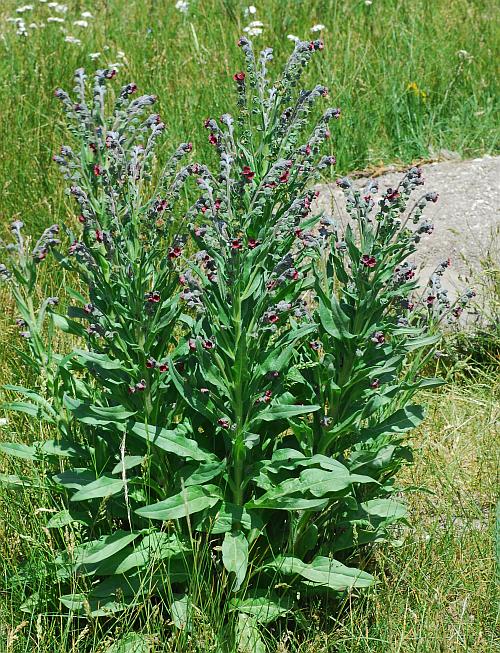Cynoglossum officinale L.
Common Hound's Tongue

Introduced
CC = *
CW = 5
MOC = 25
© SRTurner
Cynoglossum officinale L.Common Hound's Tongue | |
 |
Introduced CC = * CW = 5 MOC = 25 |
© SRTurner |
|
Family - Boraginaceae Habit - Biennial forb with stout, woody taproot. Stems - Erect, to 60 cm, densely pubescent with slender, soft, woolly hairs, leafy to the tip. Leaves - Basal and alternate. basal leaves well developed at flowering, relatively large (10-30 cm long, 20-50 mm wide), the blade oblanceolate to elliptic or oblong-elliptic, tapered at the base into a long, winged petiole, grading abruptly into the stem leaves. Stem leaves mostly sessile, oblanceolate to narrowly elliptic, narrowly oblong-elliptic, or narrowly lanceolate, tapered to rounded at the base, sometimes slightly clasping the stem, angled or tapered to a sharply pointed tip, grading into the bracts, the upper surface moderately roughened-pubescent with stiff, pustular-based hairs, the undersurface moderately to densely hairy with fine, softer hairs.
Inflorescences - Elongate, ascending, terminal, scorpioid, spikelike racemes, usually grouped into panicles, the flowers with stalks 2-12 mm long at flowering, usually elongating to 5-12 mm at fruiting, drooping at fruiting, the flowers lacking bracts but most inflorescence branch points with leaflike bracts 1-5 cm long.
Flowers - Calyces actinomorphic, 5-lobed, hairy, 6-10 mm long at fruiting, spreading or loosely cupped around the fruit, broadly elliptic to broadly ovate. Corollas 4-7 mm long, actinomorphic, purplish red, the tube relatively short, the throat with 5 small, hairy, scalelike appendages, the lobes 3-5 mm long. Stamens 5, attached near the midpoint of the corolla tube, the filaments short, the anthers oblong to elliptic, not exserted from the corolla. Ovary deeply 4-lobed, the style relatively short and not exserted from the corolla, usually persistent and sometimes becoming stout and tapered from the base at fruiting, the stigma capitate, shallowly 2-lobed.
Fruits - Fruits dividing into usually 4 nutlets, these 5-7 mm long, asymmetrically broadly obovoid, attached to the narrowly pyramidal gynobase at the tip (but appearing to be attached laterally toward the base), the attachment scar large and surrounded by a well-developed rim, rounded or bluntly pointed at the tip, somewhat flattened along the dorsal surface, the surface with dense, stout, tapered, apically barbed tubercles and sometimes also finely wrinkled, pale gray to nearly white or tan to dull brown.
Flowering - May - July. Habitat - Riverbanks, pastures, fields, roadsides, open disturbed areas. Origin - Native to Eurasia. Lookalikes - Cynoglossum creticum, which is even rarer in Missouri. Other info. - This striking species with maroon flowers has been found in scattered counties in Missouri, mostly in the eastern and southern regions of the state. It is an unwelcome invader across a large swath of the northwestern U.S., where it is considered a noxious weed. It is less common and apparently less aggressive in the northeastern part of the country and Missouri. Collection data for Missouri suggest that it may be slowly declining in the state, as the large majority of collections were made prior to 1970. The large scorpioid inflorescences, maroon flowers, and interesting fruits make this plant conspicuous and impossible to mistake. Photographs taken in Yellowstone National Park, Park County, WY, 7-20-2014, near Three Forks, Gallatin County, MT, 6-11-2015, Spokane, Spokane County, WA, 6-12-2015, and Treasure Falls, Mineral County, CO, 6-23-2015 (SRTurner). |